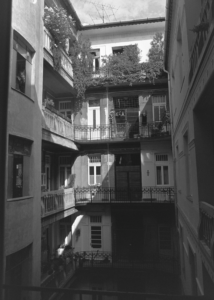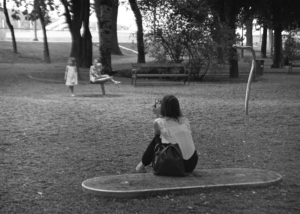


Wanting to give my photos more texture, I started experimenting with vintage lenses. Using a 30-dollar adapter, Canon lenses gathering dust can be slapped on a DSLR (in this case a Rebel t5, nothing fancy, but we all have to start somewhere). I had a few old lenses lying around, but wanted more variety, so I hunted down a few on eBay.
Usually, they were sold with an SLR body, which, at first, I had no intention of bringing back to life. I had fun shooting with old-school 18-100, a 28mm, 50 and 85 fixed lens, adapted to my t5. I liked the resulting grainy texture they added to the 0s and 1s. The drawback is that your aperture is rendered useless and appears as an ominous 00 on your screen. You’re left with adjusting the shutter speed in manual mode.
The focus is also a bit tricky–the sweet spot is harder to hit, but also, well, sweeter. While packing the lenses for a trip to Hungary, the A-1 body kept crying out from its well-cushioned case. On a whim, I bought four rolls of black and white film (ISO 400) on amazon and a few days later, nervously threaded my first roll of film since high school. I tried to remember what our hippie photography teacher had taught us about loading film, but it was YouTube who saved me once again. Not just with loading, but on the functions of the A-1, which are pretty extensive. Hailing from 1978, the A-1 was the first fully automatic SLR from Canon, which had built-in metering, shutter and aperture priority modes.
I figured I would take it along and see how the photos taken with the Rebel and the ones with the A-1 differed. During the 10-day long trip, I usually carried both cameras and switched between them guided purely by instinct. Shooting on film is different, like carrying a precious vase across the room. Aware that there’s no going back, you pay attention more to composition and exposure. Is this shot really worth taking? flashes across your mind, something that rarely does when shooting digital.
I mostly used the aperture priority mode, which means the camera adjust the shutter speed accordingly for a good exposure. This is where the max 1000 shutter speed of the A-1 is a limiting factor. Arriving in the middle of a European heat wave, the brutal sun often made me with for a higher shutter speed. Even at the highest f stop, I feared the photos in bright sunlight would be overexposed.
When I got back to Brooklyn, I dropped the film off at Bushwick Community Darkroom, to be developed and scanned. Three days later, the link to Dropbox arrived in my e-mail and I could view the scans. My expectations were cautiously modest, but I was pleasantly surprised. Most of the photos were exposed (and developed) properly. For some reason, a lot of them lacked contrast, (maybe a function of the ISO?) which I fixed in Photoshop. Maybe that’s cheating, but we need all the help we can get.
I selected a few for comparison. https://www.flickr.com/gp/158961071@N04/2P2n80
The color photo, shot on digital is followed by an analog analogue (as much as possible, a similar setting). Color aside, there is a different feel to the black and white shots. They have a grainy texture that seems more organic and earthy (one day a wine connoisour will come up with words to describe the ‘flavor’ of photos) than digital. They have nostalgic appeal. Some of the shots evoked photos from my childhood, when my grandfather took pictures of us using his East German Praktika. This was a beast of a camera which I inherited and subsequently lost and it still haunts me to this day.
Mixing analog and digital technology yields interesting results, but it also has practical uses. Restoring old photos is a cinch with Photoshop, for instance. One of the shots on the black and white roll had a flaw in it. It’s one of my sister with her two daughters and I fixed it in Photoshop. https://flic.kr/s/aHsmmiPf8W
Overall, I’m excited about the possibilities of incorporating analog technology into the digital mix. For something to be new again, all you have to do is wait, as the saying goes. The impetus for using vintage lenses is to shoot video that looks less “digital”. The crisp, everything-in-focus look may work for photos, but when telling a story, I prefer soft focus and a little blur around the edges. I have just bought a Canon D6 and plan to use it with vintage lenses to shoot a short in November. I’ll keep you posted on its progress on this blog.
My previous short film, Blood Brothers, https://www.amazon.com/dp/B076FDCRS6 was shot on a Canon D70 and while I like the look, I want to push it further into the land of soft focus and filmic grain with my next one.
If you have experimented with old lenses, or film photography, drop me a line. Let’s compare notes.
David Toth